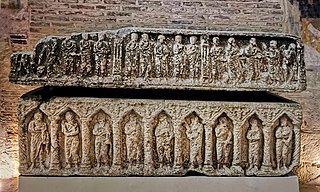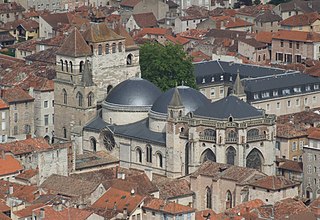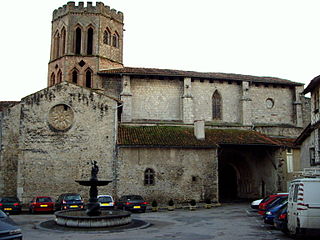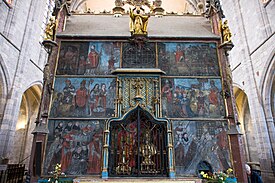Religious life
Bertrand became a canon of Saint Augustine in Toulouse, and then successively archdeacon of Toulouse (circa 1070) and Lugdunum Convenarum (taking office between 1078 and 1080). In this role, which he maintained until his death, he implemented in his mountain diocese principles of the Gregorian reform, both in regard to the discipline of clergy as religious and moral life of the laity. He participated in the reform councils of Bordeaux (1093), Clermont (1095) and Poitiers (1100). [2]
During his long episcopate, almost half a century, [3] the city of Lugdunum Convenarum - which would later take his name, Saint-Bertrand-de-Comminges - was revived. It became a stop for pilgrims on the way to Santiago de Compostela. He rebuilt the cathedral, with its Romanesque cloister. The cathedral would later be dedicated in his honour. It is listed as a UNESCO World Heritage Sites of the Routes of Santiago de Compostela in France.

Alfonso Jordan, also spelled Alfons Jordan or Alphonse Jourdain (1103–1148), was the Count of Tripoli (1105–09), Count of Rouergue (1109–48) and Count of Toulouse, Margrave of Provence and Duke of Narbonne (1112–48).

The Comminges is an ancient region of southern France in the foothills of the Pyrenees, corresponding approximately to the arrondissement of Saint-Gaudens in the department of Haute-Garonne. This region is normally associated with the former domain of the Counts of Comminges, although an earlier definition is based on the Diocese of Comminges, which appeared to include a small part of Aragon.

The Basilica of Saint-Sernin is a church in Toulouse, France, the former abbey church of the Abbey of Saint-Sernin or St Saturnin. Apart from the church, none of the abbey buildings remain. The current church is located on the site of a previous basilica of the 4th century which contained the body of Saint Saturnin or Sernin, the first bishop of Toulouse in c. 250. Constructed in the Romanesque style between about 1080 and 1120, with construction continuing thereafter, Saint-Sernin is the largest remaining Romanesque building in Europe. The church is particularly noted for the quality and quantity of its Romanesque sculpture. In 1998 the basilica was added to the UNESCO World Heritage Sites under the description: World Heritage Sites of the Routes of Santiago de Compostela in France.

Saint-Bertrand-de-Comminges is a commune (municipality) and former episcopal see in the Haute-Garonne department in southwestern France. It is a member of the Les Plus Beaux Villages de France association.

William III Taillefer was the Count of Toulouse, Albi, and Quercy, as well as the Marquis of Gothie from 972 or 978 to his death. He was the first of the Toulousain branch of his family to bear the title marchio, which he inherited from Raymond II of Rouergue.

The Roman Catholic Metropolitan Archdiocese of Montpellier (–Lodève–Béziers–Agde–Saint-Pons-de-Thomières) is an archdiocese of the Latin Church of the Roman Catholic Church in south-western France. It was probably created in the 3rd century AD. The current metropolitan archbishop is Pierre-Marie Carré; the immediate past Archbishop Emeritus is Guy Marie Alexandre Thomazeau. On September 16, 2002, as part of the reshuffling of the map of the French ecclesiastical provinces, the diocese of Montpellier ceased to be a suffragan of Avignon and was elevated to archdiocese and metropolitan of a new ecclesiastical province, with the dioceses of Carcassonne, Mende, Nimes and Perpignan–Elne as suffragans.

The Roman Catholic Diocese of Cahors is a diocese of the Latin Church of the Roman Catholic Church in France. The diocese comprises the whole of the department of Lot.

The Diocese of Rodez (–Vabres) is a Latin Church ecclesiastical territory or diocese of the Catholic Church in France. The episcopal see is in Rodez. The diocese corresponds exactly to the Department of Aveyron.

The former French Catholic diocese of Comminges existed at least from the sixth century, to the French Revolution. The seat of the bishops was at Saint-Bertrand-de-Comminges, now no more than a village, in the modern department of Haute-Garonne in south-west France. The territory of the old diocese now belongs to the archdiocese of Toulouse. The name of Comminges was incorporated into the titulature of the archbishop of Toulouse on 19 January 1935. He is now the archbishop of Toulouse-Saint Bertrand de Comminges-Rieux.

The former French Catholic diocese of Couserans existed perhaps from the fifth century to the French Revolution in the late eighteenth century. It covered the former province of Couserans, in south-west France. Its episcopal seat was in Saint-Lizier, a small town to the west of Foix. It was a suffragan of the archdiocese of Auch.

The former French Roman Catholic Diocese of Saint-Papoul, now a Latin titular see, was created by Pope John XXII in 1317 and existed until the Napoleonic Concordat of 1811.

The Roman Catholic Archdiocese of Toulouse is an ecclesiastical territory in France. The diocese comprises the Department of Haute-Garonne and its seat is Toulouse Cathedral. Archbishop Guy de Kerimel has been its head since 2021.
The former Roman Catholic Diocese of Lombez existed, with see at Lombez in the present department of Gers in Gascony, from 1317 to the Napoleonic reshuffle after the French Revolution.

The Roman Catholic Diocese of Pamiers, Couserans, and Mirepoix is a diocese of the Latin Church of the Roman Catholic Church in southern France. The diocese comprises the department of Ariège and is suffragan to the Archdiocese of Toulouse. The diocese of Pamiers is divided into five Deaneries: Pamiers, Foix, Haut-Ariège, Couserans, and Pays-d'Olmes-Mirapoix. The episcopal see is the Cathedral of Saint Antoninus in the city of Pamiers.

The Roman Catholic Diocese of Montauban is a diocese of the Latin Church of the Roman Catholic Church in France. The diocese is coextensive with Tarn-et-Garonne, and is currently a suffragan of the Archdiocese of Toulouse. The episcopal seat of the Diocese of Montauban is in Montauban Cathedral.

Saint-Bertrand-de-Comminges Cathedral is a former Roman Catholic cathedral in Saint-Bertrand-de-Comminges, Haute-Garonne, southwestern France. It was the seat of the Ancient Diocese of Comminges.

UNESCO designated the Routes of Santiago de Compostela in France as a World Heritage Site in December 1998. The routes pass through the following regions of France: Aquitaine, Auvergne, Basse-Normandie, Bourgogne, Centre, Champagne-Ardenne, Ile-de-France, Languedoc-Roussillon, Limousin, Midi-Pyrénées, Picardie, Poitou-Charentes, and Provence-Alpes-Côte d'Azur. UNESCO cites the routes' role in "religious and cultural exchange", the development of "specialized edifices" along the routes, and their "exceptional witness to the power and influence of Christian faith among people of all classes and countries in Europe during the Middle Ages".

Guillaume d'Aure, OSB, was born in Toulouse, France and died on 3 December 1353 in Avignon. He was a French Benedictine monk and Cardinal. He was the son of Bernard VII Dodon, Count of Comminges, and Bertrande, Countess d'Aure, daughter of Arnaud, Vicomte de l'Arboust. He had a brother, Raymond Roger d'Aure.
Bertrand of L'Isle-Jourdain may refer to:
Bertrand de L'Isle-Jourdain (1227–1286) was the bishop of Toulouse from 1270 until his death.


















